BLOG, or DIE. Author Bio
Thursday, 26 March 2009
A real Good guy
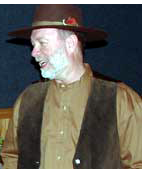 A few years ago, I wrote a short, retrospective essay titled Birth of a Buff. In it, I shared the story of how my parents first introduced me to the Civil War during a family vacation to Gettysburg in 1978. You can view that essay, along with some incredibly cute photos of yours truly, over on my website. If not for the efforts of my mom and dad, who knows what kinds of shenanigans I would have fallen into? Another individual who deserves credit for cultivating my interest in the "Great Divide" is Mr. David Good, my 6th grade history teacher.
A few years ago, I wrote a short, retrospective essay titled Birth of a Buff. In it, I shared the story of how my parents first introduced me to the Civil War during a family vacation to Gettysburg in 1978. You can view that essay, along with some incredibly cute photos of yours truly, over on my website. If not for the efforts of my mom and dad, who knows what kinds of shenanigans I would have fallen into? Another individual who deserves credit for cultivating my interest in the "Great Divide" is Mr. David Good, my 6th grade history teacher. I turn 37 in just a few weeks, and there are very few things that I can still remember from my days at Manilla Elementary School. Most of them however, took place in my American history class. You know that teacher who seemed to have a gift for igniting interest in his/her students, the kind of teacher that presented their curriculum in a totally captivating way, and the type of teacher that you actually looked forward to seeing in class each week? That was Mr. Good. His teaching style was extraordinary and he left an indelible impression on me that lasts to this very day.
You could say that he alone gave me my start as a writer. I distinctly remember penning one of my first historical pieces for him. It was a report on Francis Marion "The Swamp Fox" and Mr. Good told us stories about how he and his friends would pretend to be Continental and British soldiers while playing army in the woods. I also recall when he came to class dressed entirely in fringed-buckskin (ala Davy Crockett). He was teaching us about the French and Indian War and brought along his black powder musket to demonstrate how tedious the process for loading and firing was. Imagine a teacher bringing a working firearm to school nowadays. Times sure have changed, and not for the better.
When I returned from my trip to Gettysburg, Mr. Good immediately recognized my newfound interest in the War Between the States and he was patient enough to allow me to contribute to the class with my limited knowledge. He set up a special display in the glass case outside his classroom and filled it with my souvenirs from the trip. I distinctly recall how proud I was to get that kind of special recognition. I also remember how anxious I was to get my stuff back.
Mr. Good even encouraged me to create a special project for extra credit. I made a small diorama of the battle at Little Round Top. Starting with a shoebox, I cut one side off, and made a landscape w/ terrain out of clay, sticks and rocks. I also cut the cover off a Gettysburg brochure that looked like soldiers silhouetted in the woods and used that as a background. Finally, I placed tiny blue plastic soldiers representing Chamberlain's 20th Maine on top of the hill and scattered gray members of Hood's division along the slope. (I also recall having a stream represented at the bottom of the hill, which was not topographically accurate. I don't think he marked me on that one.)
My 6th grade year happened to be the last ever in this school. It was closed down and later became the borough building, police headquarters, and library for our community. The faculty was scattered among the various schools in our district and I moved on to Middle School never to see my favorite history teacher again. I did think of him from time to time, most recently during a weekend trip to Gettysburg in which my father and I returned to where it all began.
For the last four years, ever since I published my first Civil War book, I have been trying to track down Mr. Good to thank him for the tremendous affect his tutelage had on my personal and professional life. A couple years ago I managed to get a hold of my elementary school librarian who informed me that Mr. Good had retired in 2005 after teaching 33 years in Keystone Oaks School District.
Bummed beyond words, I thought that was it, and gave up on the prospect of reaching him. Luckily, through the wonders of Facebook (and the networking of some other teachers that I am fond of) mentor and student have finally been reunited.
It turns out that Mr. Good never lost his enthusiasm for history, especially the American West. Today he is a member of the River Junction Shootist Society and practices the lost art of cowboy action shooting. He is also an avid cyclist and has toured Civil War battlefields on 2 wheels with fellow faculty. Over the last few days, we have communicated via email and we are planning to chat on the phone this weekend.
I believe that we all need to take the time to thank those who had a positive influence on us. Let them know they mattered. If you had a Mr. Good in your life, I highly recommend seeking him/her out. The Internet has opened up a whole new world of opportunities to get reacquainted with our past. Use it. It's well worth the effort.

Tuesday, 24 March 2009
March 28: Voices from the Storm program
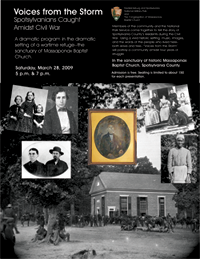 Our good friend John Hennessy of the Fredericksburg- Spotsylvania National Military Park Service just sent me information on a wonderful event that is taking place this Saturday at the historic Massaponax Baptist Church in Spotsylvania County. In addition to standing just down the road from the Aubrecht homestead, MBC was also the site of Alexander Gardner’s famous photo of Grant’s War Council. On Saturday, the NPS will present two, one-of-a-kind programs (5 pm & 7 pm) that present the experiences of those who witnessed the Civil War firsthand. Admission is free. View event poster (PDF). Here is the promo:
Our good friend John Hennessy of the Fredericksburg- Spotsylvania National Military Park Service just sent me information on a wonderful event that is taking place this Saturday at the historic Massaponax Baptist Church in Spotsylvania County. In addition to standing just down the road from the Aubrecht homestead, MBC was also the site of Alexander Gardner’s famous photo of Grant’s War Council. On Saturday, the NPS will present two, one-of-a-kind programs (5 pm & 7 pm) that present the experiences of those who witnessed the Civil War firsthand. Admission is free. View event poster (PDF). Here is the promo:
No place in America suffered more during war than Spotsylvania. Children, churches, parents, and homesteads--all were caught in a maelstrom that transformed them. On Saturday March 28, members of the community, Massaponax Baptist Church, and the National Park Service come together to tell the story of Spotsylvania’s residents during the Civil War. Using a vivid historic setting, music, images, and the words of the people who lived here–-both slave and free--”Voices from the Storm: Spotsylvania's Great Trial ” will portray a community amidst four years of struggle.

Friday, 20 March 2009
Thank you Manassas
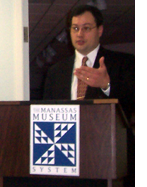 I literally just got back from my lecture at Manassas Museum on “The Historical Churches of Fredericksburg: A Study in Race-Relations.” I was glad that my newest program was received well and I now have two tentative talks scheduled through members of the audience. For this particular piece I focused specifically on three churches and their pre-war conflicts over racial inequalities.
I literally just got back from my lecture at Manassas Museum on “The Historical Churches of Fredericksburg: A Study in Race-Relations.” I was glad that my newest program was received well and I now have two tentative talks scheduled through members of the audience. For this particular piece I focused specifically on three churches and their pre-war conflicts over racial inequalities.
My presentation discussed the split between the whites and blacks attending Fredericksburg Baptist, resulting in Shiloh Baptist (Old Site), as well as the denominational split between the Methodist churches over the issue of slavery. As usual, I will post the complete transcripts and slides over on my website later this week.
In the meantime, here is a 2-minute Quicktime uncompressed video that my daughter Madison shot. (It’s a tad large and may take a minute or two to load. In it I am explaining the segregated entrances and seating areas at Massaponax Church and the tensions that existed at Fredericksburg Baptist.)
3/21 UPDATE: I posted the complete transcripts from my talk "Houses of the Holy: A study in pre-war race relations at Fredericksburg's landmark churches." Read Here

Q&A with Sean Allen Pratt
This week I had the pleasure of speaking with one of my favorite historical individuals, one Dr. Hunter Holmes McGuire, personal physician and surgeon on General Thomas Jackson's staff. Of course you may recall that the good doctor was responsible for the successful amputation of "Stonewall's" left arm following an accidental wounding at the Battle of Chancellorsville. He then went on after the Civil War to become a brilliant doctor, author, president of the American Medical Association, and father of 10 children before dying from a cerebral embolism on September 19, 1900.
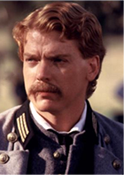 Of course when I say that I spoke to the "good doctor," it was actually through an equally gifted actor who portrayed the man in the critically acclaimed, and sometimes panned movie God's and Generals. Despite anyone's personal issues with the film (many consider it to be Lost Cause propaganda), no one can deny the quality of acting it offered and the excellent job that the cast did in bringing their characters to life. Personally, I have always enjoyed watching G&G (in the context of a Hollywood film) and two performances that always stood out in my mind were of course Stephen Lange's portrayal of Gen. Jackson, and Sean Allen Pratt's depiction of Dr. McGuire. As these two gentlemen shared so many scenes together, each complimented the other on screen.
Of course when I say that I spoke to the "good doctor," it was actually through an equally gifted actor who portrayed the man in the critically acclaimed, and sometimes panned movie God's and Generals. Despite anyone's personal issues with the film (many consider it to be Lost Cause propaganda), no one can deny the quality of acting it offered and the excellent job that the cast did in bringing their characters to life. Personally, I have always enjoyed watching G&G (in the context of a Hollywood film) and two performances that always stood out in my mind were of course Stephen Lange's portrayal of Gen. Jackson, and Sean Allen Pratt's depiction of Dr. McGuire. As these two gentlemen shared so many scenes together, each complimented the other on screen.
Sean Allen Pratt's resume in film, television, and theater is extremely impressive and he has played many complex and dynamic characters over the course of his career. His credits include on film: Gods and Generals, Tuck Everlasting, Iron Jawed Angels and Ladder 49; on television roles: The District, Homicide and The Wire; and on stage: Oedipus The King and The Game Of Love And Chance. In addition to his acting, Sean holds seminars and workshops for actors looking to break into the biz.
Via Facebook, Sean was nice enough to discuss his thoughts on playing perhaps the most celebrated surgeon in Civil War history. I asked him how he prepared for the part:
SEAN: I read a boatload of books about the Civil War, conducted Internet research on him and his family, traveled to Richmond to see his statue and the CW Medical Museum, took a lot of horseback riding lessons and tried not to lose my hat during any of the battle scenes. We had a standing deal that whoever had their hat knocked/blown off during a big scene had to by a round at the bar that evening....I bought my share. Stephen Lange had a great line about our costumes, "These wool uniforms are great. They keep you hotter than hell in the summer and colder then ice in the winter."
As a student of "Stonewall," I have used more than my share of the doctor's transcripts and I have always been impressed with his commitment to preserving the stories of his time as the lead physician on Jackson's staff. I live just a few miles from the Stonewall Jackson Shrine (where he died at Guinea Station). I often lead private tours there and I speak about the fallen general's emergency surgery at Wilderness Tavern. I always quote Dr. McGuire's report as the fact that Jackson survived the perilous ambulance ride from the Chancellorsville area to Caroline County testifies to his gifts as a military surgeon.
I also asked Sean if he came away from the G&G project, having studied and portrayed such a noteworthy individual, with a different impression of the Civil War.
SEAN: Beyond the awe of being involved in a film project of that size (which quite literally was like an army on the move), I came away with two things: The understanding of how men could deal with the loss of thousands of soldiers in one battle as a matter of course, even as a "glorious" thing, and the utter grief caused by the death of one man. Also, how far we have come from such notions of the antebellum ideas of "honor," "duty," "forbearance," and what constitutes the concept of "The United States of America."
Sean also added that he is currently in the process of narrating the new Abraham Lincoln bio by Michael Burlingame and that it will be released through Audible.com. For more on Sean Pratt's work, visit his website SEAN PRATT PRESENTS.

Wednesday, 18 March 2009
Never forget
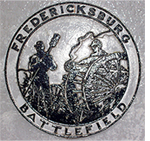 Last night I had the pleasure of giving a private tour of the Fredericksburg Battlefield to a visiting film director from Savannah Georgia named Clint Ross and his lovely wife Lizzie. Both had spent the day up at Chatham Manor, gathering sources from the National Military Park Service’s archives and they were anxious to visit our hallowed ground. We met at the Visitor’s Center downtown around 5:30 and then slowly walked the surrounding area as the sun set. Our hike took us from the National Cemetery, down the Marye’s Heights Trail to the Sgt. Richard Kirkland Monument, and back along the Sunken Road. Clint was in town doing research for a very special documentary project that he is working on. I really enjoyed sharing the stories of noteworthy witnesses such as the stubbornly courageous Martha Stephens who is said to have ridden out the battle in her house near the Stone Wall and later tore strips from her own garments to bind the wounds of the fallen.
Last night I had the pleasure of giving a private tour of the Fredericksburg Battlefield to a visiting film director from Savannah Georgia named Clint Ross and his lovely wife Lizzie. Both had spent the day up at Chatham Manor, gathering sources from the National Military Park Service’s archives and they were anxious to visit our hallowed ground. We met at the Visitor’s Center downtown around 5:30 and then slowly walked the surrounding area as the sun set. Our hike took us from the National Cemetery, down the Marye’s Heights Trail to the Sgt. Richard Kirkland Monument, and back along the Sunken Road. Clint was in town doing research for a very special documentary project that he is working on. I really enjoyed sharing the stories of noteworthy witnesses such as the stubbornly courageous Martha Stephens who is said to have ridden out the battle in her house near the Stone Wall and later tore strips from her own garments to bind the wounds of the fallen.
Obviously they had done a great deal of reading about the Battle of Fredericksburg in preparation of their visit and Clint and his wife asked some really great questions that facilitated discussion. I was very glad that he had an opportunity to visit Chatham where the Federal artillery was positioned on Stafford Heights, and then accompany me to the ridge of Marye’s Heights where the Washington Artillery had positioned their guns. The perspective of course was the distance between both sides and the city and the expanse in between that was essentially an artillerist’s shooting range. As we stood atop the bluff near the Gen. Andrew A. Humphreys monument and watched the sun set, I recalled a piece that I had posted several years ago that seemed appropriate for the occasion. I quoted the piece “Then Vs. Now” as it summarizes my personal feelings as a local historian and outlines the understanding I would like visitors to take with them. Here is the 'short' version:
When you come to Fredericksburg and tour her hallowed grounds, everything is perfect. The grass is neatly trimmed and the markers are polished. The freshly painted cannons are all lined up neatly and the landmark buildings are restored to their original splendor. Depending on the time of year, there can be rows and rows of flags or luminaries in the cemeteries and you can often find living historians or re-enactor’s walking about. These romantically peaceful and serene settings unfortunately make it far too easy to forget that at the time of the war, specifically as the events that made these spots memorable in the first place transpired, the fields, roads, and downtown areas were absolutely devastated. In fact, it was probably not at all a nice place to be. The scene was likely one of anguish and atrocity, as dead soldiers and horses covered the ground. At the time, millions of flies and the stench of black powder and rotting flesh filled the air. The sickening sights that littered the city were the scenes that nightmares are made of. In other words, touring a Civil War battlefield means literally walking among the dead. Therefore, we must consciously remind ourselves that the beauty of these places is a façade and that the men that fought and died there baptized the very soil we stand on today with their blood. Never forget that. The next time that you find yourself touring one of these picturesque places, try to remember that although our National Battlefields are beautiful, the war that took place on them was ugly.

Newer | Latest | Older
 A few years ago, I wrote a short, retrospective essay titled Birth of a Buff. In it, I shared the story of how my parents first introduced me to the Civil War during a family vacation to Gettysburg in 1978. You can view that essay, along with some incredibly cute photos of yours truly, over on my website. If not for the efforts of my mom and dad, who knows what kinds of shenanigans I would have fallen into? Another individual who deserves credit for cultivating my interest in the "Great Divide" is Mr. David Good, my 6th grade history teacher.
A few years ago, I wrote a short, retrospective essay titled Birth of a Buff. In it, I shared the story of how my parents first introduced me to the Civil War during a family vacation to Gettysburg in 1978. You can view that essay, along with some incredibly cute photos of yours truly, over on my website. If not for the efforts of my mom and dad, who knows what kinds of shenanigans I would have fallen into? Another individual who deserves credit for cultivating my interest in the "Great Divide" is Mr. David Good, my 6th grade history teacher. 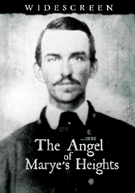
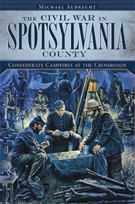
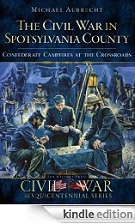

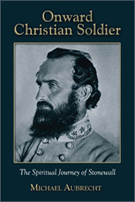

 Our good friend John Hennessy of the Fredericksburg- Spotsylvania National Military Park Service just sent me information on a wonderful event that is taking place this Saturday at the historic Massaponax Baptist Church in Spotsylvania County. In addition to standing just down the road from the Aubrecht homestead, MBC was also the site of Alexander Gardner’s famous photo of Grant’s War Council. On Saturday, the NPS will present two, one-of-a-kind programs (5 pm & 7 pm) that present the experiences of those who witnessed the Civil War firsthand. Admission is free.
Our good friend John Hennessy of the Fredericksburg- Spotsylvania National Military Park Service just sent me information on a wonderful event that is taking place this Saturday at the historic Massaponax Baptist Church in Spotsylvania County. In addition to standing just down the road from the Aubrecht homestead, MBC was also the site of Alexander Gardner’s famous photo of Grant’s War Council. On Saturday, the NPS will present two, one-of-a-kind programs (5 pm & 7 pm) that present the experiences of those who witnessed the Civil War firsthand. Admission is free.  I literally just got back from my lecture at Manassas Museum on “The Historical Churches of Fredericksburg: A Study in Race-Relations.” I was glad that my newest program was received well and I now have two tentative talks scheduled through members of the audience. For this particular piece I focused specifically on three churches and their pre-war conflicts over racial inequalities.
I literally just got back from my lecture at Manassas Museum on “The Historical Churches of Fredericksburg: A Study in Race-Relations.” I was glad that my newest program was received well and I now have two tentative talks scheduled through members of the audience. For this particular piece I focused specifically on three churches and their pre-war conflicts over racial inequalities.  Of course when I say that I spoke to the "good doctor," it was actually through an equally gifted actor who portrayed the man in the critically acclaimed, and sometimes panned movie God's and Generals. Despite anyone's personal issues with the film (many consider it to be Lost Cause propaganda), no one can deny the quality of acting it offered and the excellent job that the cast did in bringing their characters to life. Personally, I have always enjoyed watching G&G (in the context of a Hollywood film) and two performances that always stood out in my mind were of course Stephen Lange's portrayal of Gen. Jackson, and Sean Allen Pratt's depiction of Dr. McGuire. As these two gentlemen shared so many scenes together, each complimented the other on screen.
Of course when I say that I spoke to the "good doctor," it was actually through an equally gifted actor who portrayed the man in the critically acclaimed, and sometimes panned movie God's and Generals. Despite anyone's personal issues with the film (many consider it to be Lost Cause propaganda), no one can deny the quality of acting it offered and the excellent job that the cast did in bringing their characters to life. Personally, I have always enjoyed watching G&G (in the context of a Hollywood film) and two performances that always stood out in my mind were of course Stephen Lange's portrayal of Gen. Jackson, and Sean Allen Pratt's depiction of Dr. McGuire. As these two gentlemen shared so many scenes together, each complimented the other on screen. Last night I had the pleasure of giving a private tour of the Fredericksburg Battlefield to a visiting film director from Savannah Georgia named Clint Ross and his lovely wife Lizzie. Both had spent the day up at Chatham Manor, gathering sources from the National Military Park Service’s archives and they were anxious to visit our hallowed ground. We met at the Visitor’s Center downtown around 5:30 and then slowly walked the surrounding area as the sun set. Our hike took us from the National Cemetery, down the Marye’s Heights Trail to the Sgt. Richard Kirkland Monument, and back along the Sunken Road. Clint was in town doing research for a very special documentary project that he is working on. I really enjoyed sharing the stories of noteworthy witnesses such as the stubbornly courageous Martha Stephens who is said to have ridden out the battle in her house near the Stone Wall and later tore strips from her own garments to bind the wounds of the fallen.
Last night I had the pleasure of giving a private tour of the Fredericksburg Battlefield to a visiting film director from Savannah Georgia named Clint Ross and his lovely wife Lizzie. Both had spent the day up at Chatham Manor, gathering sources from the National Military Park Service’s archives and they were anxious to visit our hallowed ground. We met at the Visitor’s Center downtown around 5:30 and then slowly walked the surrounding area as the sun set. Our hike took us from the National Cemetery, down the Marye’s Heights Trail to the Sgt. Richard Kirkland Monument, and back along the Sunken Road. Clint was in town doing research for a very special documentary project that he is working on. I really enjoyed sharing the stories of noteworthy witnesses such as the stubbornly courageous Martha Stephens who is said to have ridden out the battle in her house near the Stone Wall and later tore strips from her own garments to bind the wounds of the fallen.